Abstract
The flow rate of tubular fluid has been suggested as one of several factors which may influence potassium transport in the distal convoluted tubule of the kidney. In the present micropuncture studies, the relationship between the flow rate of distal tubular fluid and potassium transport was examined in four groups of rats. Three groups of rats (I, II, and IV) were fed normal rat chow before study whereas one group (III) was fed chow containing 10% KCl. Group II received 10-20 μg/kg per h of d-aldosterone throughout the study. Distal tubular potassium transport in groups I, II, and III was examined before and after an increase in the flow rate of distal tubular fluid as induced by the infusion of an isotonic saline-bicarbonate solution equivalent to 10% of body weight. In group IV, distal tubular potassium transport was examined before and after enhancement of the flow rate by the infusion of hypertonic (15%) mannitol.
In all four groups, distal tubular potassium secretion increased as the flow rate of tubular fluid increased. The nature of the relationship between distal tubular potassium transport and tubular fluid flow rate, however, was influenced by the extent to which the tubular fluid to plasma potassium ratio in the late distal tubule varied as the flow rate increased. As the flow rate was increased this ratio decreased significantly and to a comparable extent in groups I and II. In groups III and IV, on the other hand, this ratio was essentially identical during hydropenia and after the increase in the flow rate of tubular fluid. As a result, the increment in the amount of potassium present at the late distal tubule, which occurred as the flow rate increased, was significantly greater in groups III and IV than in groups I and II. The contrast in the relationship between the flow rate of distal tubular fluid and potassium transport which were observed, probably reflects differences in the net driving force for cell to lumen potassium movement. Seemingly, the net driving force for potassium movement was maintained, as the flow rate of tubular fluid increased, by chronic potassium loading in group III and by hypertonic mannitol infusion in group IV. In groups I and II, the net driving force for potassium movement decreased as the flow rate of tubular fluid increased. However, the net driving force did not decrease in proportion to the increase in flow rate since potassium secretion was increased by increments in flow rate in these groups as well.
We conclude that our results are consistent with the view that the flow rate of tubular fluid is a factor which can affect distal tubular potassium transport. However, the nature of the relationship between the flow rate of tubular fluid and potassium transport appears to depend upon the degree to which the driving force for cell to lumen potassium movement changes as the flow rate is varied.
Full text
PDF
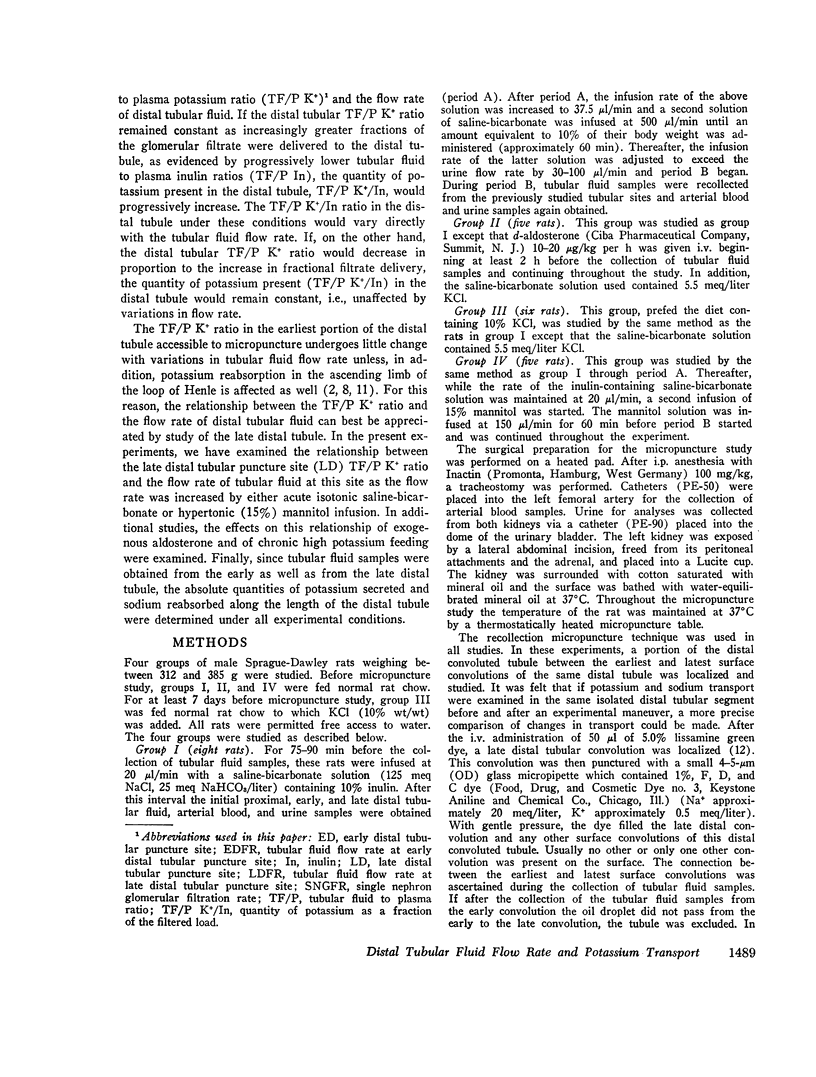
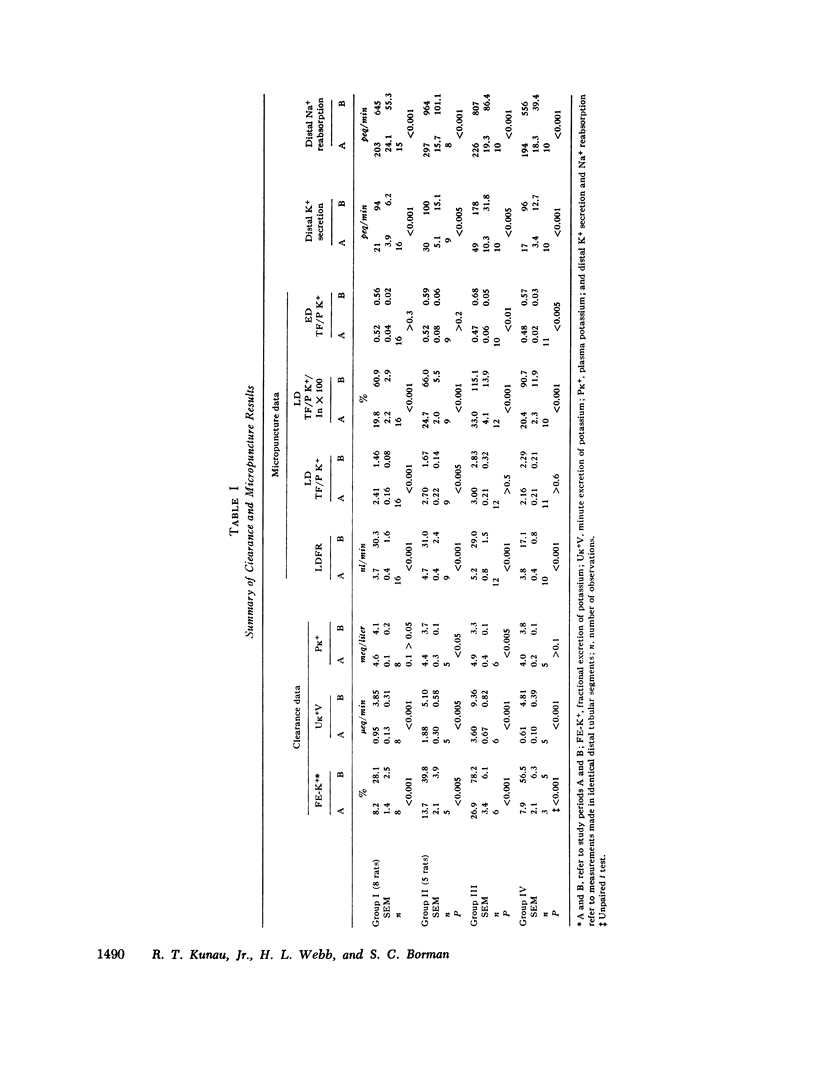

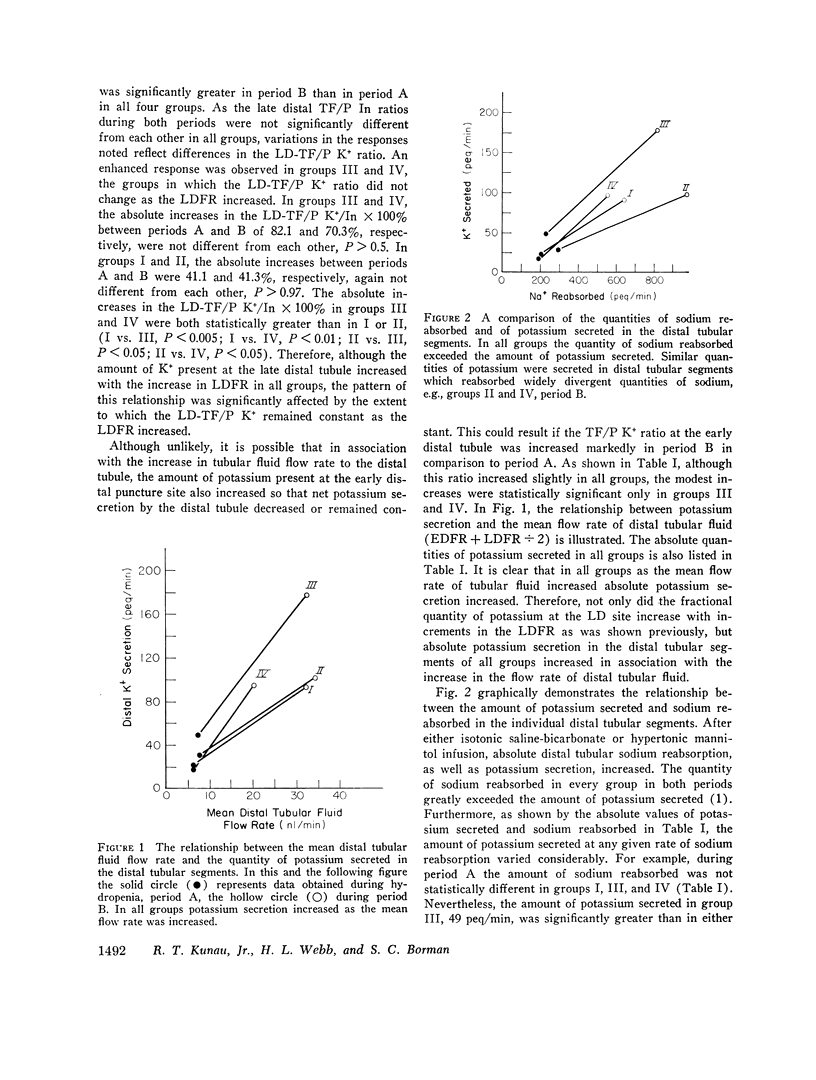
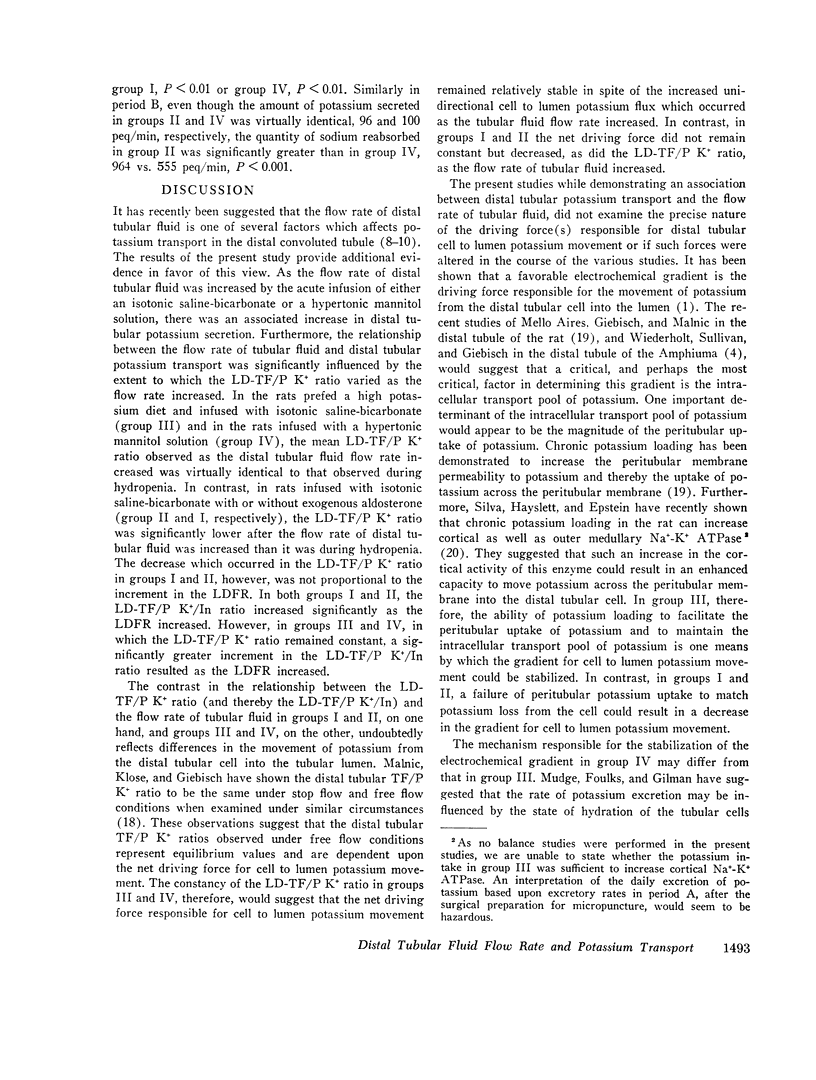
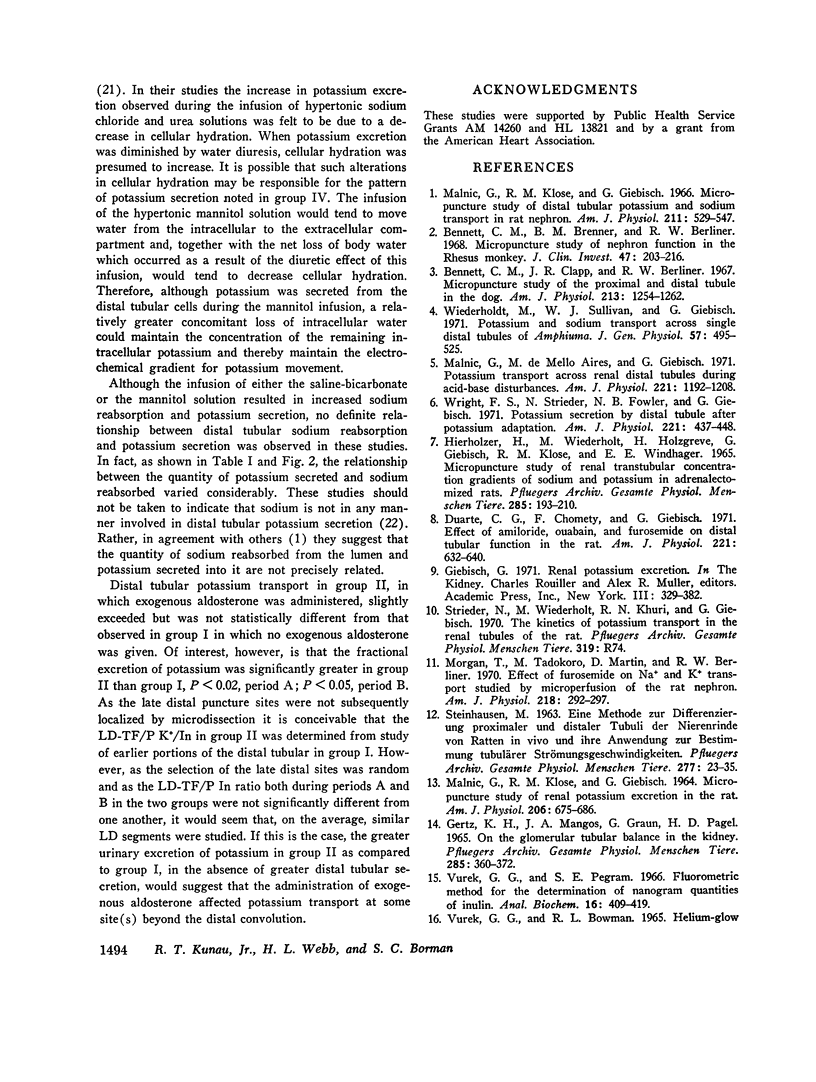
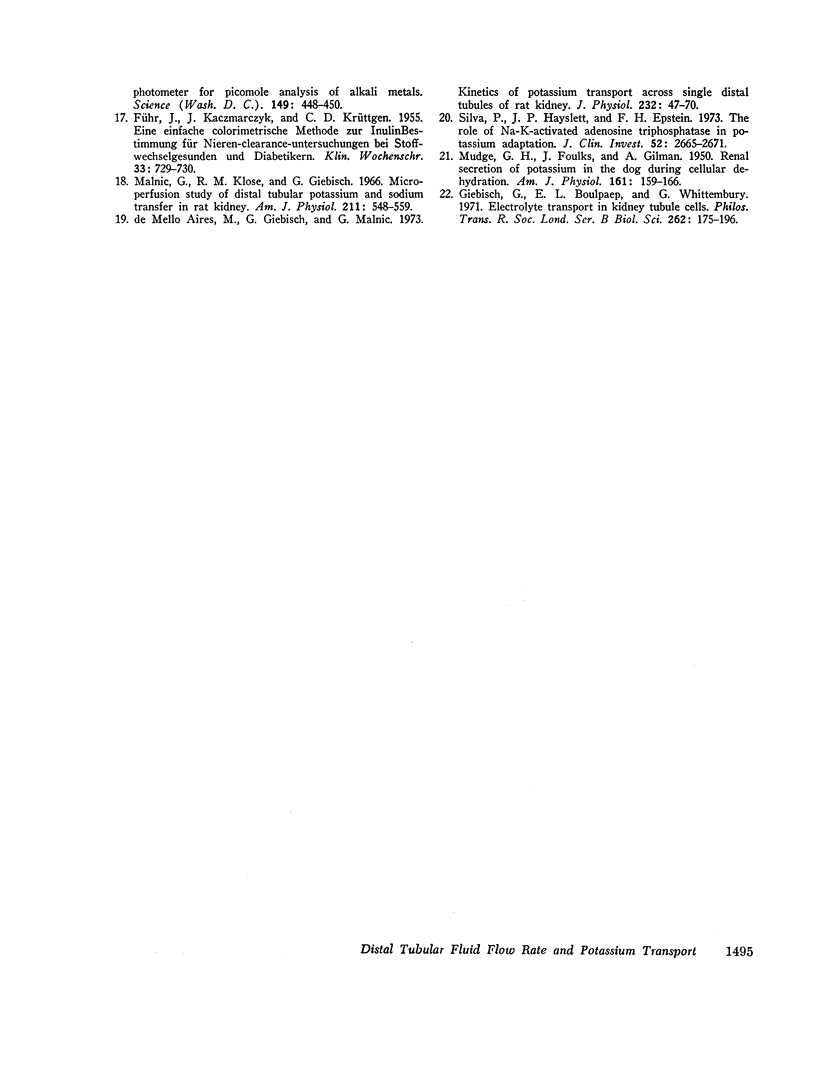
Selected References
These references are in PubMed. This may not be the complete list of references from this article.
- Bennett C. M., Brenner B. M., Berliner R. W. Micropuncture study of nephron function in the rhesus monkey. J Clin Invest. 1968 Jan;47(1):203–216. doi: 10.1172/JCI105710. [DOI] [PMC free article] [PubMed] [Google Scholar]
- Bennett C. M., Clapp J. R., Berliner R. W. Micropuncture study of the proximal and distal tubule in the dog. Am J Physiol. 1967 Nov;213(5):1254–1262. doi: 10.1152/ajplegacy.1967.213.5.1254. [DOI] [PubMed] [Google Scholar]
- Duarte C. G., Chomety F., Giebisch G. Effect of amiloride, ouabain, and furosemide on distal tubular function in the rat. Am J Physiol. 1971 Aug;221(2):632–640. doi: 10.1152/ajplegacy.1971.221.2.632. [DOI] [PubMed] [Google Scholar]
- FUHR J., KACZMARCZYK J., KRUTTGEN C. D. Eine einfache colorimetrische Methode zur Inulinbestimmung für Nieren-Clearance-Untersuchungen bei Stoffwechselgesunden und Diabetikern. Klin Wochenschr. 1955 Aug 1;33(29-30):729–730. doi: 10.1007/BF01473295. [DOI] [PubMed] [Google Scholar]
- Gertz K. H., Mangos J. A., Braun G., Pagel H. D. On the glomerular tubular balance in the rat kidney. Pflugers Arch Gesamte Physiol Menschen Tiere. 1965 Sep 15;285(4):360–372. doi: 10.1007/BF00363236. [DOI] [PubMed] [Google Scholar]
- Giebisch G., Boulpaep E. L., Whittembury G. Electrolyte transport in kidney tubule cells. Philos Trans R Soc Lond B Biol Sci. 1971 Aug 20;262(842):175–196. doi: 10.1098/rstb.1971.0088. [DOI] [PubMed] [Google Scholar]
- MALNIC G., KLOSE R. M., GIEBISCH G. MICROPUNCTURE STUDY OF RENAL POTASSIUM EXCRETION IN THE RAT. Am J Physiol. 1964 Apr;206:674–686. doi: 10.1152/ajplegacy.1964.206.4.674. [DOI] [PubMed] [Google Scholar]
- MUDGE G. H., FOULKS J., GILMAN J. Renal secretion of potassium in the dog during cellular dehydration. Am J Physiol. 1950 Apr 1;161(1):159–166. doi: 10.1152/ajplegacy.1950.161.1.159. [DOI] [PubMed] [Google Scholar]
- Malnic G., De Mello Aires M., Giebisch G. Potassium transport across renal distal tubules during acid-base disturbances. Am J Physiol. 1971 Oct;221(4):1192–1208. doi: 10.1152/ajplegacy.1971.221.4.1192. [DOI] [PubMed] [Google Scholar]
- Malnic G., Klose R. M., Giebisch G. Microperfusion study of distal tubular potassium and sodium transfer in rat kidney. Am J Physiol. 1966 Sep;211(3):548–559. doi: 10.1152/ajplegacy.1966.211.3.548. [DOI] [PubMed] [Google Scholar]
- Malnic G., Klose R. M., Giebisch G. Micropuncture study of distal tubular potassium and sodium transport in rat nephron. Am J Physiol. 1966 Sep;211(3):529–547. doi: 10.1152/ajplegacy.1966.211.3.529. [DOI] [PubMed] [Google Scholar]
- Morgan T., Tadokoro M., Martin D., Berliner R. W. Effect of furosemide on Na+ and K+ transport studied by microperfusion of the rat nephron. Am J Physiol. 1970 Jan;218(1):292–297. doi: 10.1152/ajplegacy.1970.218.1.292. [DOI] [PubMed] [Google Scholar]
- Silva P., Hayslett J. P., Epstein F. H. The role of Na-K-activated adenosine triphosphatase in potassium adaptation. Stimulation of enzymatic activity by potassium loading. J Clin Invest. 1973 Nov;52(11):2665–2671. doi: 10.1172/JCI107460. [DOI] [PMC free article] [PubMed] [Google Scholar]
- Wiederholt M., Sullivan W. J., Giebisch G. Potassium and sodium transport across single distal tubules of Amphiuma. J Gen Physiol. 1971 May;57(5):495–525. doi: 10.1085/jgp.57.5.495. [DOI] [PMC free article] [PubMed] [Google Scholar]
- Wright F. S., Strieder N., Fowler N. B., Giebisch G. Potassium secretion by distal tubule after potassium adaptation. Am J Physiol. 1971 Aug;221(2):437–448. doi: 10.1152/ajplegacy.1971.221.2.437. [DOI] [PubMed] [Google Scholar]
- de Mello-Aires M., Giebisch G., Malnic G. Kinetics of potassium transport across single distal tubules of rat kidney. J Physiol. 1973 Jul;232(1):47–70. doi: 10.1113/jphysiol.1973.sp010256. [DOI] [PMC free article] [PubMed] [Google Scholar]


